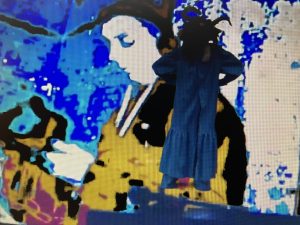‘Pop-Up Bridges: Quick and Dirty Live Streams’ by UKRAiNATV and #StreamArtStudio crew, 10th March, 2023 at FramerFramed (Amsterdam), during the In-Between-Media two-day event,
Report by Valeria Ferrari
In the program we can the following description:
“This workshop will focus on setting up and creating links between different spots, internet platforms, hardware and software connections, signals, and forms of hybrid togetherness. During the 3-hour working process, we will test the possibilities of a DIY and DIT streaming set-up, building a temporary POP-UP STUDIO in the space of Framer Framed as well as create media bridges between the UKRAiNATV #StreamArtStudio in Krakow (PL) and—hopefully—a second studio in Kyiv (UA), together with the Carbon group. We will work with streaming in both an aesthetic and ethical way, moving in-between platforms, places, and possibilities, mixing and meeting people, machines, and signals in a ‘transhuman vibe’. All of this with the aim to (potentially) do virtual politics, or just to hang out in a hybrid way, despite the shade of geopolitical tensions and most likely the lack of power (in all meanings of this word).”
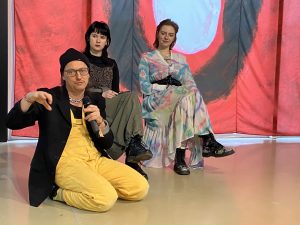
We are in the large and bright exposition space of Framer Framed; the set-up organized by the UKRAiNATV crew makes it look like one of those edgy production studios in the industrial areas of Brooklyn. Except that it isn’t: the cameras are small and the cables excessive, ready to go to war.
While the lunch break slowly comes to an end, people gather around the screens in the workshop area. The sound of the rain on the roof ceases: now it’s big flakes of snow that we see falling softly on the other side of the glass walls.
The workshop set-up is composed of two big screens, wired with laptops, and wired with cameras (three in total, connected to the laptop via HDMI). The latter is located at the centre of the space, pointing at a solitary empty chair. The audience – a group of a dozen people happily fed and seated in a curve line facing the monitors – can already see, on the big screens, a confusing image. The camera is immortalizing the space where we are in: we can see, mirrored, the big red art piece hanging from the wall, the empty chair in front of us. But there is also another chair, on the screen, that we can’t see in the room. The presence of that chair signals that we have started the connection with the studio in Krakow. The two studios are now merged on the screen: the two chairs, one in Amsterdam and one in Krakow, facing each other.
The workshop – and to be true, the entire UKRAiNATV project – puts technical work, content, performativity and attention to the socio-political conditions, in a continuum.
The process of setting up is taking longer than expected. If in the studio in Krakow Roman knows intimately each and every cable. Here everything is new, and the procedure needs to be re-tested and re-performed, with slightly different technical manoeuvres. Their studio in Krakow is entirely surrounded by a green screen, here we have art pieces in the background. There is, here, an audio expert: they don’t normally separate the audio from the video handling, so this is a new dynamic for them. But technical issues are a constitutive part of their studio set-up. From their studio in Poland, the connection with Kyiv is always a struggle. That’s how it is.
Refresh, and make sure the signal flows. Yes, Krakow is with us.
Finally, everything is working: the signal from Amsterdam is sent to the studio in Krakow, and from there the final output is transmitted to various streaming platforms, mostly Twitch and YouTube. The streaming event can start.
“It’s important to focus on what we see,” says Roman while putting Tommaso behind one of the cameras. In the meantime, the participants are invited to move closer, walk around the set-up, and play with the equipment.
Before making more technological magic happen, and while technical operations continue in the background, Ksenia takes the microphone to tell us more about UKRAiNATV:
We are a TV, but not a usual one: we are an internet TV station. We try to be everywhere, we try to be on as many platforms as we can. Social media are controlled by BigTeh companies, which can censor you, and shut you down. The least you can do is to diversify, in order to keep continuity: you never know when you can be kicked out from one, but then you have another. And we are trying to build our own website as well.
First of all, we are a community, we try to build togetherness. Our community gathers people from different countries: Giulia is Italian, I am from Belarus, and Roman is Polish. People come from different places and we welcome new ideas. Every day new students come to us, and we are open to explore with them. We are not a closed project, anyone can enter and contribute. Personally, I could have never imagined doing what I am doing right now, and I still have no idea of what is going on.
UKRAiNATV was born the in the days following the start of the war. It wanted to be a tool to help people. All of a sudden, a lot of people were entering the country as refugees, and the government was not always helpful. So, we, first of all, tried to build connections, and create bridges between people in need and people who wanted to help, but didn’t know how to. We were organizing assistance, collecting food, and searching for accommodation.
I was born and raised in a dictatorship, with absolutely no media freedom. UKRAiNATV changed everything in the way I see media. When I started with them, the first thing I thought was that the consequences of broadcasting in the way we do would have been devastating. But actually, nothing happened. We could tell stories, invite Ukrainian artists, and provide a spot, a safe space, for people who were starting a new life in a new country. We organized a 24-hour stream event, for the anniversary of the start of the war, that was totally hybrid, online and offline. On that occasion, we stayed in the studio for 3 days consecutively, eating and sleeping there. So no, it is not a normal TV studio, is a place of connection and encounter: among people, and between people and media.
I feel like I am giving a Ted Talk.
We laugh, realising how lost we actually are in her story.
They are the weirdest people I have met. I never thought I would meet someone weirder than me, but here they are.
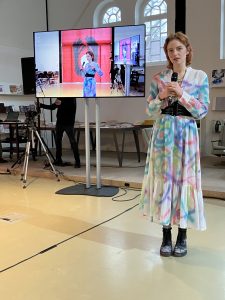
UKRAiNATV is not for propaganda, not for money; we want to be interesting, help people, and give opportunities to young Ukrainian artists to show themselves. Not many Slavic people have the opportunity to talk, to be shown, and to have a voice. We try to help people overcome the feeling of guilt. And it is fundamental for this project to exist in Krakow, because it is where a lot of Ukrainian artists are coming to find shelter, to find a place where to express themselves.
I AM IN LOVE WITH UKRAiNATV.
The crowd is not large, and the atmosphere is intimate and immersive. We are completely involved with the speech, with the screening going on in the background. We are finally establishing the connection with Krakow. Gleb, connecting from the Polish studio, is now on the screen with us. He is performing with music and vocals: the techno music is now surrounding us, and his vocals invite us to embrace responsibility and care for each other – “LOVE AND BE LOVED” at the rhythm of techno beats. We can see Gleb playing and bouncing on the screen, and we are in his background. The audience is galvanized by the overlapping of images, seeing themselves captured from an unexpected angle, mirrored behind the DJ in Krakow!
Both from our set-up and from the Krakow studio, software is used to manipulate the image. We see images from the different cameras switching, overlapping with images from Krakow. Our video output (the camera is now pointed at the two computer screens from which Roman is controlling the stream) is Gleb’s input: while he is standing in front of a green screen, the image we broadcast becomes his background. He has also set his own modifications: a visual loop that follows his body waving with the music.
Roman explains that the situation with audio is sometimes complicated: the audio loop makes noises. There can be delays. For this reason, it is important to keep things together – audio and video – to avoid further confusion.
Everybody is in the circle, listening, trying to grasp these complex technical details.
“We want to connect with Kyiv as well, coming together in a hybrid way,” says Roman while a new person appears for a second on the screen, drinking a glass of wine, and quickly disappears.
We now want to stay in Krakow, and have a conversation with Gleb. The techno in the background turns louder – it’s going to be the most complicated part of the workshop.
Gleb has taken a seat and is now facing Ksenia, virtually, on the screen. Knenia appears oddly smaller than him: we need to fix the proportions of the images; now Ksenia looks a lot bigger than him; between the general laughter, we finally find the right dimensions, and the two can virtually shake hands.
Suddenly, a toy dog appears between them on the screen.
Gleb starts talking:
The reason why I can’t be there is that I am still waiting for the documents to be legally in Poland. I have been here more than a year, but without documents, I can’t move out of the country.
We are creating borderless bridges between places, spaces and people – Krakow is one of the main hubs. We are connecting points with data, words and music, in ways that are visible and invisible.
I hope they have electricity generators in Kyiv: yesterday there was an attack and everyone woke up at night to the noises of war. The whole city was hit by bombs and missiles. My grandfather–a painter, writer, social activist, and a man of his city, woke up at night with broken windows falling on his body.
We ask Gleb to tell us what UKRAiNATV means to him, to share his history.
I started with making a poster, then we organized a finissage. Performances, painting on clothes and canvas, installations, a craft market. Everything happened so fast. It was only after months, in December, that I started asking myself what was going on, what are we doing here. We had to decide what we are: a platform? A program?
It’s something difficult to categorize.
We are space, we are people, we are active signals.
“We are trying to destroy borders with every streaming effort we are making” (Ksenia)
Geert now moves to the chair, facing Gleb on the screen. He asks him about the involvement of Ukranian artists, the live connection with Kyiv.
It started with Kirovs’k getting free from the Russian occupation: it is from there that people started to come here to perform. And then people from Odessa.
(The speech is interrupted by “impulses of signals coming”)
There are three types of artists’ involvement with our lab: people who are around us, in Krakow, who don’t have other possibilities to perform: even just to perform a DJ set in front of a greenscreen; people that are always here, at the lab; people that are coming and going, not only from Ukraine.
We also see our art as a cultural front line: we are an independent source of information, that is not filtered or edited: unique stories go out from here, stories that would not appear in normal television, in normal Twitch streams made by someone working on his own business.
“Independence and freedom are the conditions to spread truth and real facts.” (Gleb)
In the meantime, all sorts of things are happening on the two screens: people dancing, a person laying on a big inflatable flamingo…
Then Donatella Della Ratta takes the seat to ask a question to Gleb, about the choice of aesthetics: why is the atmosphere of the live stream so joyful, why are the colours so bright?
What we experience are borderline feelings of going crazy for happiness and sadness at the same time. Under the war you are in a condition of constant, daily fear; this kind of visual joyfulness reminds us of what we are fighting for: freedom, independence, to have back our happiness. In our streams, we mirror that hope. We are not just dancing and going crazy with colour and music: we are telling stories, letting people express their feelings, in ways a formal environment would not allow. We know that behind the bright colours we are crying inside: a colourful picture is not always connected to happiness and carelessness. The bright aesthetics is more about strong feelings and strong signalling. It’s about being full of feelings of hope.
We want to break the tabu of showing war zones only with grey, sad esthetics.
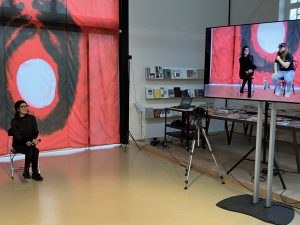
Donatella asks Gleb to elaborate on his opinion about the political situation: what does it mean, for you, to be against the war?
Our statement is that every decision, every political move that helps Ukraine get free from the Russian invasion is good. I don’t know how it will look like when it ends. It doesn’t matter to me right now, let it be how God wants. The main thing right now is to get the Ukrainian people safe.
[the whole time people come and go, in and out of the screen, the movements are projected with delay – it seems speakers are being very unpolite to each other, leaving without saying goodbye]
[a pixelated fire appears at the bottom of the screen]
We finally connect with Kyiv. We watch the transmission of a pre-recorded streaming performance: it’s a 3d video showing a desert, abandoned broken houses and big statues with sad faces. Laser shooting hit the ground, causing the sand to explode, moving it in waves, like water hit by rocks. In the background, techno music.
Now we are seeing a live music performance in Kyiv. The musician, VJ Yarkus, is in a room filled with boxes and cables, no light coming in, other than the one on the computer screen. The walls are made of bare bricks, it looks like a basement. Suddenly, right above the DJ commands, appears a small figure: a creature, with the head of a monstrous lion, dancing and waving its long dress. It is the dance performer, from the Krakow studio, who just joined the streaming.
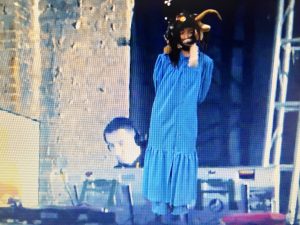
Everything is running smoothly, so Roman can sit with us to watch the joined music & dance performance that from Kyiv and Krakow converges on our screen.
The performance lasts for 20 minutes, during which the crowd relaxes, stretch their legs while following the obscure dance happening on the screen. When it comes to and end, Ksenia finally introduces Giulia, the VRChat artist from the team. Giulia presents us the story of Snake Island where they decided to set the VRChat, reading a poetic text piece that she wrote about it.
What we are doing is creating digital spaces for people to come together and perform. The VR chat is one of these. I started this project for my personal research, and now it’s part of UKRAiNATV. In this VR space, people who enter can participate in a drawing performance, covering the island with colour. When the performance is over, the drawing disappears. It’s ephemeral, just like everything that was on the island where it takes place.
VRChat is also an opportunity to play with the limitations of YouTube, Giulia explains, limitations on streaming permission: we have a multiplayer set-up inside VRChat, meaning we wrap signals from other platforms inside the chat, so that we can make collaborative screenings.
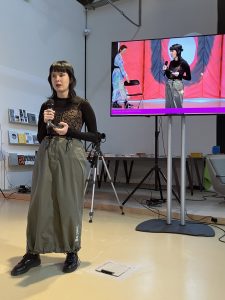
In the meantime, Ksenia has entered the VR room: we see her moving her hands, turning her head on all sides; it seems like she is dancing, but she is actually drawing (or she is actually doing both at the same time). She is drawing in the air, on the island, joined by some comrades from Krakow who can enter the same room and draw with her.
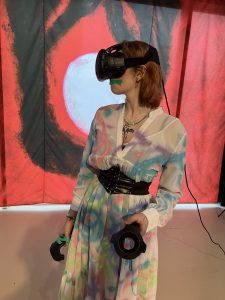
Then Giulia invites the crowd to try VRChat and explore the island themselves.
Finally, the event fades away slowly while – still filled with the loud, metallic sounds of ambient techno coming from Kyiv – the room is slowly set for the closing session.
Roman closes the workshop, inviting us to stay tuned with UKRAiNATV.
